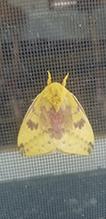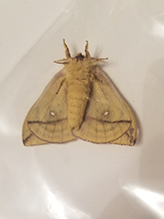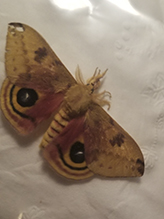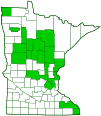io moth
(Automeris io)
Conservation • Description • Habitat • Ecology • Distribution • Taxonomy
|
|
||||||||||||||||||
Description |
Io moth is a common, short-lived, day flying, medium to large-sized moth. It occurs in North America east of the Rocky Mountains, in Mexico, and in Central America. Adults are ¾″ to 1⅜″ (20 to 35 mm) long and have a wingspan of 2″ to 3⅛″ (50 to 80 mm). On the male, the thorax is covered with yellow hairs. On the female it is covered with reddish-brown hairs. The forewings of the male are bright yellow with dark brown markings. There is always irregular dark spotting on the reniform spot; a dark, jagged, interrupted, antemedial line; and a dark, scalloped, postmedial line that fades in the middle. There is sometimes a dark spot on the outer margin at the wing tip, dark spots along the subterminal line, and a broad dark area on the inner margin. The wingtips are pointed at an angle slightly greater than 90°. The forewings of the female are reddish-brown, dark, and more pointed, the angle slightly less than 90°. The hindwings are mostly yellow with a large eyespot, a broad red area on the inner margin, and a thin red subterminal line. The eyespot is very large and black, with a gray or blue iris and a white pupil. It is surrounded with bright yellow and a has thin black line below. On the female the eye spot is larger and the subterminal line is wider. First stage (instar) caterpillars are dark brown. Second and third instars are dull orange or orangish-brown. The fourth instar is tan or beige with a prominent stripe (spiracular stripe) on each side through the breathing pores (spiracles). The spiracular stripe is narrow, white, and bordered above by a thin, red stripe. The fifth (last) instar caterpillar is bright green, also has a thin red and white spiracular stripe, and is up to 2½″ long. On the upper (dorsal) surface of each abdominal segment there is a tuft of pale green, two-branched (bifurcated), irritating (urticating) hairs. There is a similar but smaller tuft on the side of each segment. |
Size |
Total length: ¾″ to 1⅜″ (20 to 35 mm) Wingspan: 2″ to 3⅛″ (50 to 80 mm) |
Similar Species |
Habitat |
Deciduous woodlands and forests, meadows, orchards, parks, and suburban areas |
Ecology |
Season |
One generation per year: Late May through June |
Behavior |
When handled, the irritating hairs on the caterpillar break of in the skin. The sting is similar to that of stinging nettle, but unlike with that plant, the sting lasts for hours. |
Life Cycle |
Eggs are laid on the leaves of host plants. Larvae pass through five stages (instars) in about four weeks. They overwinter in the pupal stage and emerge as adults the following summer. Adults live only one or two weeks. |
Larva Hosts |
Mostly leaves of deciduous trees and shrubs, including maple, oak, willow, hackberry, blackberry, and gooseberry; but also leaves of other plants, including corn and clover. |
Adult Food |
Adults are active during the day. They do not feed. The wings are held closed and flat when at rest. When disturbed they will quickly open their wings displaying the large, owl-like, eye spots on the hindwings. |
Distribution |
||
|
Sources |
|
| 11/29/2024 | ||
Occurrence |
||
Common |
||
Taxonomy |
|
Order |
|
Superfamily |
Bombycoidea (hawk, sphinx, silk, emperor, and allied moths) |
Family |
Saturniidae (emperor and giant silk moths) |
Subfamily |
Hemileucinae (buck and io moths) |
Tribe |
Hemileucini |
Genus |
Automeris (eyed silkmoths) |
Subordinate Taxa |
|
io moth (Automeris io io) io moth (Automeris io neomexicana) |
|
Synonyms |
|
|
|
Common Names |
|
io moth |
|
Glossary
Reniform spot
A kidney-shaped spot or outline in the lower median area near the PM line on the forewing of many moths.
Spiracle
A small opening on the surface of an insect or arachnid through which it breathes.
Visitor Photos |
||
Share your photo of this insect. |
||
This button not working for you? |
||
Luciearl |
 |
trail |
Bruce L. |
||
...released after pictures taken |
||
 |
 |
|
 |
||
MinnesotaSeasons.com Photos |
||
|
||
|

Slideshows |
|

Visitor Videos |
||
Share your video of this insect. |
||
This button not working for you? |
||
|
Other Videos |
||
Io Moth (Automeris io) |
About
Published on Dec 17, 2018 This video highlights the lifecycle of one of Florida's most impressive and dangerous insects. From false eye spots to stinging caterpillars, the Io moth is a fascinating insect. |
Caterpillar Sting Test |
About
Published on Dec 5, 2012 http://www.facebook.com/quaoarpower Automeris io caterpillar sting in Mariposario Montezuma Gardens, Costa Rica |
Caterpillar: Io Moth (Automeris io) |
About
Published on Apr 9, 2015 Phillip found this cool little guy the other day—a vivid green, fuzzy caterpillar with a red and white stripe. Some quick research revealed it to be an immature Io Moth. The “fuzzy” things are actually spines that can release a very painful venom, so it’s good we didn’t touch it :). |
IO Moth |
About
Published on May 19, 2012 |

Visitor Sightings |
||
Report a sighting of this insect. |
||
This button not working for you? |
||
| Luciearl 8/24/2024 |
Location: Lake Shore trail |
| Bruce L. 7/6/2019 |
Location: Island Lake, Hubbard County ...released after pictures taken |
 |
MinnesotaSeasons.com Sightings |
||
|

Created: 9/6/2019 Last Updated: © MinnesotaSeasons.com. All rights reserved. |
